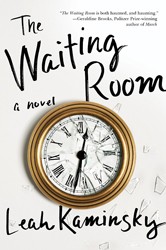Leah Kaminsky is the author of the novel The Waiting Room. She will be guest blogging for the Jewish Book Council all week as part of the Visiting Scribe series here on The ProsenPeople.
Ah, the dead, the unended, endlessly ending dead: how long, how rich is their story. We, the living, must find what space we can alongside them…
– Salman Rushdie, The Moor’s Last Sigh
There has been a long line of literary specters. Ghosts have appeared in fiction throughout the ages, embodying a diversity of roles and haunting a variety of characters. Some take on the form of bold and terrifying poltergeists, corybantic cadavers who rattle around demanding moral justice and vindication; others appear as mere wisps of foggy miasma, canvassing subsequent generations to bear witness to past events with little more than a whisper.
Ghosts in literary fiction are usually revealed by way of a protagonist intent on preserving their memory. By listening to and confronting the ghosts that haunt them, they are able to integrate both personal and collective pasts into their present lives, and as a result actively choose the trajectory of their own future.
Dina, the protagonist of my debut novel, The Waiting Room, is an expat Australian doctor living in Haifa during the Intifada who is haunted by her Jewish mother, a Holocaust survivor who took her own life when her daughter was only eighteen. Dina’s mother cannot rest in her grave until her daughter, a reluctant listener as a teenager, finally bears witness to her extraordinary life story. Dina is followed around by this “eternal albatross of a Jewish mother,” who kibitzes and kvetches from the wings — a bit like Samantha’s mother in the ‘60s TV series Bewitched. When the alte zachen truck comes to collect household junk, her mother nags, “The stupid dog died years ago…that rotting kennel has been sitting shiva in the corner of the stairwell ever since. Isn’t it time you stopped mourning? What are you waiting for, the dog to come back from the dead?” Theirs is a complex mother-daughter relationship, but the mother’s spectral presence ironically ends up saving her daughter’s life.
In her 2011 Boyer lectures, the wonderful Geraldine Brooks reminds readers of the dictionary definitions of the word haunt: “to be continually present in; pervade, disturb or distress.” Linguistically, it is derived from the Old Norse word heimta, “to lead home.”
Being ‘haunted’ by her mother is what eventually leads Dina to find her own psychological sense of integration, or ‘coming home.’ The moral duty of honouring the past is often fulfilled by simply passing on the story so that it will not be buried along with the dead.
In the Bible, Samuel’s ghost — conjured up by the Witch of Endor — appears before Saul to predict his demise. In Virgil’s Aenied, ghosts engage in philosophical discussion, and take a keen interest in love affairs, often rebuking their descendants for sexual shenanigans. In more contemporary literary fiction, ghosts as a representation of a protagonist’s inner, unresolved conflicts, become more prominent, such as in Anne Enright’s The Gathering, or Michael Chabon’s The Final Solution. In novels, we are able to have control over things that are uncontrollable. Within the pages of a book, the very spooks that terrify us may also be the ones that bring us an odd feeling of comfort and familiarity, as well as a sense of serenity.
 When someone close to us dies there is a ghost image of that person within us, imprinted in memory. Convincing the reader that ghosts exist, by their existence in the story, is one of the magical powers of literature. Freed from the limitations of flesh, ghosts that appear in literary texts are like reflections on the other side of a mirror, telling protagonists things about themselves they did not know. Many characters embody ghosts in order to preserve the presence of those they held dear, in part so they are able to hold them close again, by denying the fact that they are truly dead. The annoying Jewish mother my protagonist Dina ran from as a young girl is the very person she is searching for as an adult. In this way, ghosts are a device or a kind of mechanism for characters to confront and deal with death and their own mortality. Margaret Atwood sums it up well: “The ghost[…] is a way of examining the self, coming to terms with the self.”
When someone close to us dies there is a ghost image of that person within us, imprinted in memory. Convincing the reader that ghosts exist, by their existence in the story, is one of the magical powers of literature. Freed from the limitations of flesh, ghosts that appear in literary texts are like reflections on the other side of a mirror, telling protagonists things about themselves they did not know. Many characters embody ghosts in order to preserve the presence of those they held dear, in part so they are able to hold them close again, by denying the fact that they are truly dead. The annoying Jewish mother my protagonist Dina ran from as a young girl is the very person she is searching for as an adult. In this way, ghosts are a device or a kind of mechanism for characters to confront and deal with death and their own mortality. Margaret Atwood sums it up well: “The ghost[…] is a way of examining the self, coming to terms with the self.”
Leah Kaminsky is a physician and author, whose books include We’re All Going to Die, Writer MD, and Cracking the Code. She is the poetry editor for the Medical Journal of Australia.
Related Content:
Leah Kaminsky, physician and award-winning author, is Poetry Editor at the Medical Journal of Australia. Her books include We’re All Going to Die, Writer MD, and Cracking the Code. She holds an MFA in Fiction from Vermont College of Fine Arts.




